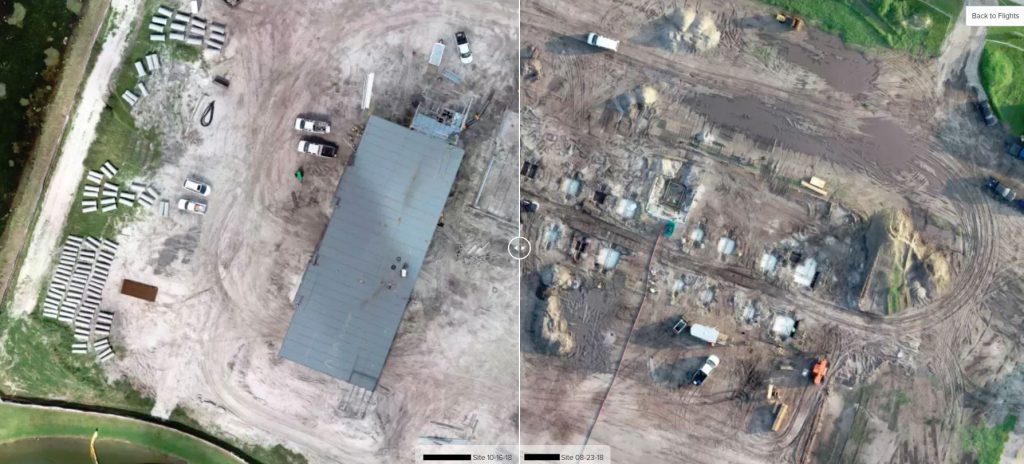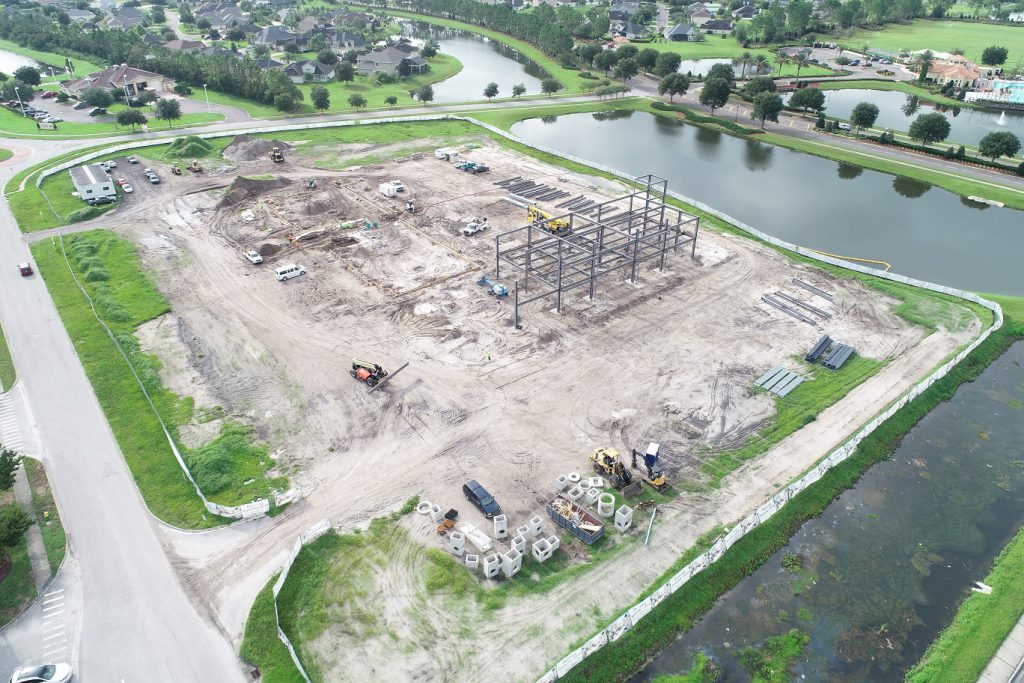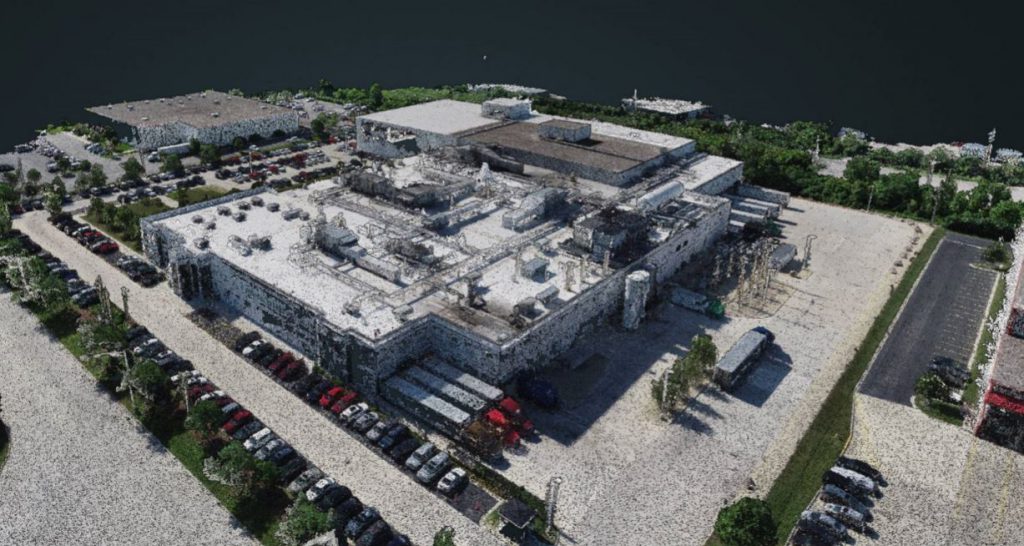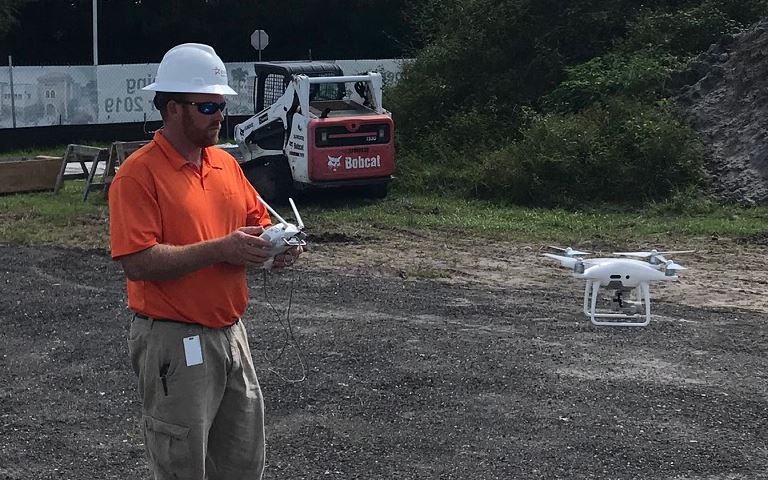Drone technology is helping redefine the way we design, construct and maintain buildings. Drones do more than just take photos — they can benefit both the builder and owner by improving design accuracy, overall quality and long-term maintenance.
Thanks to software and technology advancements, drones can be used in various stages of a building’s life and can perform several key functions, including:
- Assessing greenfield site conditions
- Aiding with site planning and layout
- Capturing construction progress photos
- Performing 3D scans of existing structures
- Creating virtual building models
- Assisting with ongoing maintenance and damage assessment
- Marketing and business development
Let’s break down these benefits and what they mean for facility owners.
1. Assessing greenfield site conditions
Owners can have a better understanding of their land investment by flying a drone over the property. Airplanes were typically used to capture these aerial photographs, but drones have become a much more efficient method for a variety of reasons:
- Drones are more cost-effective because they eliminate the overhead cost of the plane, pilot and fuel
- Planes often wait until they have several projects to photograph to make the flight time worthwhile, but drones can easily fly and capture images on-demand
- Since drones can fly at lower elevations, they aren’t impeded by cloud cover that would otherwise prevent a plane from capturing images
In addition, many sites require earthwork to prepare the land and soil for construction. In conjunction with data software, drones can measure dimensions, detect elevation changes and estimate the volume of dirt at a site. This gives owners a better idea of what they’ve purchased, and it informs the builder of how much dirt is needed to fill holes and level the site.

2. Aiding with site planning and layout
After a drone captures aerial images of a greenfield or renovation site, those photographs can be combined with the site plan to create more accurate layouts. By superimposing the drawing over an image of the actual site, designers (and owners) can easily visualize where various features — such as buildings, parking lots and landscaping — will be located. This gives the builder a tangible understanding of the site plan in the context of the land so that they can easily and accurately accommodate for geographic features and other variables.
3. Capturing construction progress photos
This is a more traditional and obvious application of drones in a construction project, but progress photos are more than just a bonus for the owner — it can help the builder proactively manage the project and detect discrepancies. Drones can be sent up weekly on pre-determined flight paths to ensure consistency in the images. Using the data software, we have the ability to compare construction progress over any time period.
By monitoring progress images and overlaying them with drawings, the builder can confirm if the project is going according to plan and monitor construction quality. These high-resolution images are very accurate, making it easy to see if everything is where it’s supposed to be. If a column is misplaced or some other element of construction deviates from the design, the builder can spot it and address the issue before it further delays the project.

4. Performing 3D scans of existing structures
One of the more powerful applications of drone technology is the ability to conduct photogrammetry scanning of an existing structure. High-resolution photos create a 3D point cloud model, allowing designers to measure everything from the windows on a building to the cars in the parking lot. This is especially useful for constructing renovations and additions, since it provides an accurate real-world representation of the existing conditions. The designer can also import the 3D point cloud model into the Revit software as a reference for model development.
We recently leveraged this technology for a project on a college campus. The Stellar team scanned the building and conducted a lighting analysis. Rather than having a designer walk through and do this manually, a drone was able to provide those scans in a fraction of the time.

5. Creating virtual building models
The 3D scans captured by drones can also be converted into models that can be “walked” in virtual reality (VR). By putting on VR goggles, an owners can see what the exterior of the finished product will look like and understand the spatial relationships between the building and building additions from a pedestrian point-of-view. When we recently renovated a hospital, we were able to show the owner what an additional generator room would look like in virtual reality before ever starting construction. The hospital also didn’t have as-built drawings, but we were able to create accurate designs based on 3D scans and move the renovation forward.
6. Assisting with ongoing maintenance and damage assessment
Drones don’t stop being useful after a building is constructed or renovated. The data captured by a drone can be used to plan and improve long-term maintenance of the structure as well. After Stellar completes a project, we turn over the as-built drawings and models created with the help of our drones. This detailed information makes it easier for the owner to renovate, manipulate and upgrade aspects of the facility in the future.
Drones equipped with thermal imaging can also fly over a building and detect if there are leaks in the building envelope. They can also identify areas of leak potential so owners can proactively maintain their facility before a small problem turns worse.
Drones can also help assess damage after a hurricane or tornado. A tornado recently tore the roof of a recent Stellar project; we were able to use a drone to safely identify the extent of the damage and plan for the proper repairs.
7. Marketing and business development
Finally, drones can capture video and photographs unlike anything else. They can reach places humans can’t, meaning you can capture a wide range of images of your building. These can be utilized in marketing collateral, on a company’s website, on social media platforms and beyond. Don’t underestimate the potential of powerful images in driving your business forward.
The future of drones in architecture, engineering and construction
Drones have really changed the game when it comes to building design and construction. Information that once took days to harness can now be captured with incredible accuracy in a matter of hours — this translates into huge time and cost savings for our clients. Like any cutting-edge technology, the research and applications of drones change continually, and Stellar is exploring how we can continue to leverage their benefits moving forward.




